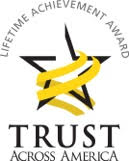
By Linda Fisher Thornton
This is the second in a series on how to repair organizational trust. It was inspired by conversations with other members of the Trust Across America Trust Alliance and my work as part of the Trust Alliance TAP team as part of #tap2021.
In this series, Trust Repair Part 1 addressed the importance of Accountability and strategies for building a robust accountability system. Trust Repair Part 2 addresses another area that the Trust Across America Trust Alliance found to be lacking in many organizations – Transparency.
Think about transparency as the ability to see the detail on small rocks at the bottom of a river. If you can’t see what color, size and shape the rocks are, the water is not transparent. Likewise, if people don’t know the “whys and hows” of what the organization is doing, there isn’t enough transparency, and the path forward is murky. When you can’t see where the rocks are, your footing is uncertain, and it’s easy to take a misstep. That uncertainty erodes trust.
Here are some strategies for embedding Transparency throughout your organization:
5 Transparency Strategies
Keep the Conversation Open (No Matter What)
No matter how difficult the subject is that needs to be discussed, keep the lines of communication open. When there are things that team members are worried about that leaders are not addressing, those worries erode trust, productivity, morale and engagement.
Deal With the Dirt
It’s easy to talk about the good things that are happening in an organization, but focusing only on those ignores the challenges people face. One of the roles of leadership is removing roadblocks that keep people from succeeding. To remove those roadblocks, we have to know what they are, and how they are impacting people. And then we need to quickly start an open and honest conversation about how best to fix them.
Teach Transparency
Transparency doesn’t come naturally to everyone. Some leaders may think that “information is power” and may hold it close. They may hesitate to trust employees with sensitive information. Some leaders may have worked other places where the prevailing view was “information is power.” Does your leadership development include the importance and logistics of frequent, sincere, open, honest, transparent communication? If not, how do you think your leaders will learn it?
Reward Transparent Communication
When you make transparency a priority, you end up having tough conversations. The good news is that those tough conversations strengthen trust and improve the bond between leaders and teams. Make sure you’re rewarding transparency and not punishing it. When people say what needs to be said in a calm way are they thanked and praised? Or are they quieted and shuffled around?
Openly Celebrate Successes
Call attention to times when leaders are transparent about their intentions and actions and keep the conversation open, improving trust and productivity. Call out those wins in a visible way so leaders know that transparency is expected, rewarded and celebrated.
Transparency is a critical element in cultures of trust and no team is so “special” that they can be allowed to decide not to be open and honest in their communication. Be sure you’re incentivizing and rewarding transparency within and across all locations and lines of business.
To learn more, visit the Trust Across America Blog and join the #Trust conversation across platforms.


Unleash the Positive Power of Ethical Leadership
© 2009-2024 Leading in Context LLC

Reblogged this on Gr8fullsoul.
LikeLike